Boeing AH-64 Apache
| AH-64 Apache | |
|---|---|
| An AH-64D Apache from U.S. Army's 101st Aviation Regiment in Iraq | |
| Role | Attack helicopter |
| National origin | United States |
| Manufacturer | Hughes Helicopters (1975-1984) McDonnell Douglas (1984-1997) Boeing Defense, Space & Security (since 1997) |
| Designer | Hughes Helicopters |
| First flight | 30 September 1975[1] |
| Introduction | April 1986[2] |
| Status | Active, in production |
| Primary users | United States Army Israel Air Force Egyptian Air Force Royal Netherlands Air Force |
| Produced | 1983–present |
| Number built | 1,174 as of February 2010[3] |
| Unit cost | AH-64A: US$20 million (2007), AH-64D (AH-64A upgrade): US$18 million (2007)[4] |
| Variants | AgustaWestland Apache |
The U.S. Army selected the AH-64 over the Bell YAH-63 in 1976, awarding Hughes Helicopters a pre-production contract for two more aircraft. In 1982, the Army approved full production. McDonnell Douglas continued production and development after purchasing Hughes Helicopters from Summa Corporation in 1984. The first production AH-64D Apache Longbow, an upgraded version of the original Apache, was delivered to the Army in March 1997. Production has been continued by Boeing Defense, Space & Security; over one thousand AH-64s have been produced to date.
The U.S. Army is the primary operator of the AH-64; it has also become the primary attack helicopter of multiple nations, including Greece, Japan, Israel, the Netherlands and Singapore; as well as being produced under license in the United Kingdom as the AgustaWestland Apache. U.S. AH-64s have served in conflicts in Panama, the Persian Gulf, Kosovo, Afghanistan, and Iraq. Israel has made active use of the Apache in its military conflicts in Lebanon and the Gaza Strip, while two coalition allies have deployed their AH-64s in Afghanistan and Iraq.
Development
Advanced Attack Helicopter
Main article: Advanced Attack Helicopter
Following the cancellation of the AH-56 Cheyenne in 1972, in favor of United States Air Force and Marine Corps projects like the A-10 Thunderbolt II and Harrier, the United States Army sought an aircraft to fill an anti-armor attack role that would still be under Army command;[5][6] the 1948 Key West Agreement forbade the Army from owning fixed-wing aircraft. The Army wanted an aircraft better than the AH-1 Cobra in firepower, performance and range. It would have the maneuverability for terrain following nap-of-the-earth (NoE) flying.[7] To this end, the US Army issued a Request For Proposals (RFP) for an Advanced Attack Helicopter (AAH) on 15 November 1972.[8][9] As a sign of the importance of this project, in September 1973 the Army designated their five most important projects, the "Big Five" with AAH included.[10]Proposals were submitted by Bell, Boeing Vertol/Grumman team, Hughes, Lockheed, and Sikorsky. In July 1973, the U.S. Department of Defense selected finalists Bell and Hughes Aircraft's Toolco Aircraft Division (later Hughes Helicopters). This began the phase 1 of the competition.[11] Each company built prototype helicopters and went through a flight test program. Hughes' Model 77/YAH-64A prototype first flew on 30 September 1975, while Bell's Model 409/YAH-63A prototype first flew on 1 October. After evaluating test results, the Army selected Hughes' YAH-64A over Bell's YAH-63A in 1976. Reasons for selecting the YAH-64A included its more damage tolerant four-blade main rotor and the instability of the YAH-63's tricycle landing gear arrangement.[12][13]
The AH-64A then entered phase 2 of the AAH program. This called for building three pre-production AH-64s, and upgrading the two YAH-64A flight prototypes and the ground test unit up to the same standard.[12] Weapons and sensor systems were integrated and tested during this time, including the laser-guided AGM-114 Hellfire missile.[14] The missile's development had began in 1974.[15][16][17]
Production history
In 1981, three pre-production AH-64As were handed over to the US Army for Operational Test II. The Army testing was successful, but afterward it was decided to upgrade to the more powerful T700-GE-701 version of engine, rated at 1,690 shp (1,259 kW). The AH-64 was named the Apache in late 1981, keeping with the Army's traditional use of American Indian tribal names for its helicopters and it was approved for full scale production in 1982.[18] In 1983, the first production helicopter was rolled out at Hughes Helicopter's facility at Mesa, Arizona. Hughes Helicopters was purchased by McDonnell Douglas for $470 million in 1984.[19] The helicopter unit later became part of The Boeing Company with the merger of Boeing and McDonnell Douglas in August 1997.[20] In 1986, the incremental or flyaway cost for the AH-64A was US$7.03 million and the average unit cost was approximately US$13.9 million based on total costs.[19]In the mid-1980s, McDonnell Douglas studied an improved "AH-64B" design with an updated cockpit, new fire control system and other upgrades. In 1988 funding was approved for a multi-stage upgrade program to improve sensor and weapon avionic systems and incorporate some digital systems.[21] However, rapidly improving technology led to the upgrade program being cancelled for more ambitious changes. Development of the more advanced AH-64D Apache Longbow was approved by the Defense Acquisition Board in August 1990. The first AH-64D prototype flew on 15 April 1992,[22] testing of the prototypes ended in April 1995; it was reported that they had significantly outperformed the AH-64A.[23][24] On 13 October 1995 full-scale production of the Apache Longbow was approved,[25] and a $1.9 billion five year contract was signed in August 1996 to upgrade and rebuild 232 existing AH-64A Apaches.[26] The first production AH-64D flew on 17 March 1997 and was delivered on 31 March.[27] The cost of the AH-64D program totaled US$11 billion through 2007.[28]
In April 2006, Boeing was awarded a $67.6 million fixed-price contract for the remanufacture of several existing US AH-64As to the AH-64D configuration; between May 2009 and July 2011, a further five contracts were issued to remanufacture batches of AH-64As to the upgraded D variant.[29] Since 2008, nations operating the older AH-64A have been urged to undertake modernization programs to become AH-64Ds, as Boeing and the US Army plans to terminate support for the A-variants in the near future.[30] The Apache's effectiveness against ground forces and in urban warfare operations was bolstered by the addition of the AGM-114N - a Hellfire missile fitted with a thermobaric warhead; the AGM-114N was approved for full production in 2005.[31] The use of thermobaric "enhanced blast" weapons has been a point of controversy.[32]
Design
The AH-64 Apache has a four-blade main rotor and a four-blade tail rotor.[33] The crew sits in tandem, with the pilot sitting behind and above the copilot/gunner.[34] The crew compartment has shielding between the cockpits, such that one crew member can survive hits. The compartment and the rotor blades are designed to sustain a hit from 23-millimeter (0.91 in) rounds. The airframe includes some 2,500 pounds (1,100 kg) of protection against ballistic strikes. The Apache also utilizes a self-sealing fuel system to protect against the loss of fuel caused by ballistic projectiles.[35]| Apache version | Engine version | Engine power |
|---|---|---|
| AH-64A | General Electric T700-701 | 1,696 shp (1,265 kW) |
| AH-64A+/D | General Electric T700-701C | 1,890 shp (1,410 kW) |
| AH-64D Block III | General Electric T700-701D | 2,000 shp (1,500 kW) |
| WAH-64D | Rolls-Royce Turbomeca RTM322 | 2,100 shp (1,600 kW) |
One of the revolutionary features at the introduction of the Apache was its helmet mounted display, the Integrated Helmet and Display Sighting System (IHADSS);[39][40] among other abilities the pilot or gunner can slave the helicopter's 30 mm automatic M230 Chain Gun to his helmet, making the gun track head movements to point at where he looks. The M230E1 can be alternatively fixed to a locked forward firing position, or controlled via the Target Acquisition and Designation System (TADS).[41][42]
The AH-64 is designed to endure front-line environments and to operate during the day or night and in adverse weather using avionics,[43] such as the Target Acquisition and Designation System, Pilot Night Vision System (TADS/PNVS), passive infrared countermeasures,[44] GPS, and the IHADSS.[41][43] A newer system that is replacing TADS/PNVS is Arrowhead (MTADS); it is manufactured by Lockheed Martin, a contract was made on 17 February 2005 to begin equipping all models of American Apaches.[45]
| Mission[33] | Hellfire | 30 mm rounds | Hydra 70 | Maximum speed (knots) | Rate of climb (feet/min) | Endurance (hours) |
|---|---|---|---|---|---|---|
| Anti-Armor | 16 | 1,200 | 0 | 148 | 990 | 2.5 |
| Covering Force | 8 | 1,200 | 38 | 150 | 860 | 2.5 |
| Escort | 0 | 1,200 | 76 | 153 | 800 | 2.5 |
For rapid deployment and transport around the world, six AH-64 Apaches can be safely fitted inside the cargo hold of a USAF Lockheed C-5 Galaxy.[50]
Operational history
United States Army
The U.S. Army formally accepted its first production AH-64A in January 1984 and training of the first pilots began later that year.[51][52] The first operational Apache unit, 7th Battalion, 17th Cavalry Brigade, began training on the AH-64A in April 1986 at Fort Hood, Texas.[53][54] Two operational units with 68 AH-64s first deployed to Europe in September 1987 and took part in large military exercises there.[53][55] The Apache was first used in combat in 1989, during Operation Just Cause, the invasion of Panama. The AH-64 participated in over 240 hours of combat attacking various targets, mostly at night.[56][57] General Carl Stiner, commander of Operation Just Cause, praised the Apache for its precision: "You could fire that Hellfire missile through a window from four miles away at night".[58]As the Army began fielding the Apache, capabilities such as use of the FLIR for extensive night-flight operations made it clear that the AH-64 was capable of travelling and fighting hundreds of kilometers beyond the forward line of own troops (FLOT) that previous attack helicopters were normally restricted to.[59] In addition to deep-strike capabilities, it was discovered that the Apache had, not by any intention, been fitted with the same Have Quick UHF radio systems used by the U.S. Air Force; once this was recognised, inter-service coordination and joint operations such as the joint air attack teams (JAAT) were encouraged and inserted into standard training. The Apache operated extensively with CAS aircraft such as the Fairchild Republic A-10 Thunderbolt II and the USMC's McDonnell Douglas AV-8B Harrier II, often acting as a target designator so the Apache could conserve its own munitions.[60]
A year after the Panama operation, close to half of all U.S. Apaches were deployed to Saudi Arabia in response to Iraq's invasion of Kuwait.[58] During Operation Desert Storm on 17 January 1991, eight AH-64As guided by four MH-53 Pave Low IIIs destroyed a portion of the Iraqi radar network;[61] the first attack of Desert Storm, an act to allow attack aircraft into Iraq without detection.[62] The Apaches carried an asymmetric load of Hydra 70 flechette rockets, Hellfires, and one auxiliary fuel tank each.[63] During the 100-hour ground war a total of 277 AH-64s took part, destroying over 500 tanks, numerous armored personnel carriers and other Iraqi vehicles.[61][64] One AH-64 was lost in the war, to an RPG hit at close range, the Apache crashed but the crew survived.[65] In order to maintain Apache operations with spare parts and support equipment, during the Gulf War the U.S. Army unofficially grounded all other AH-64s worldwide; additionally Apaches in the war zone flew only one-fifth of the flight-hours the Army had planned for.[66]
The AH-64 played roles in the Balkans during separate conflicts in Bosnia and Kosovo in the 1990s.[67][68] During these deployments the Apache encountered problems such as deficiencies in training, night vision equipment, fuel tanks, and survivability.[69][70] Deploying 24 Apaches to a land base in Albania to participate in the Kosovo engagement required 26,000 tons of equipment to be deployed and over 550 C-17 flights, at a cost of $480 million.[71] On 27 April 1999 an Apache crashed during training in Albania due to a failure with the tail rotor,[72] causing the entire fleet in the Balkans to be grounded in December 2000.[73] Major General Dick Cody, commanding officer of the 101st Airborne at the time, wrote a strongly worded memo to the US Army Chief of Staff about the failures in training and equipment.[74] The Washington Post also dedicated an front-page article to the failures in Kosovo, commenting that: "The vaunted helicopters came to symbolise everything wrong with the Army as it enters the 21st century: Its inability to move quickly, its resistance to change, its obsession with casualties, its post-Cold War identity crisis".[75] The Apache did not conduct any combat missions over Kosovo due to fears over the risk of casualties; in addition, none of the pilots were qualified to fly with night vision goggles, preventing nighttime operations.[76]
U.S. Apaches have served in Operation Enduring Freedom in Afghanistan from 2001.[77] The Apache was the only platform capable of providing accurate close air support (CAS) duties for Operation Anaconda; although they regularly took fire during the intense early fighting, they were kept operational by their ground crews.[78] American AH-64Ds typically flew in Afghanistan and Iraq without the Longbow Radar as there were no armored threats remaining.[79]
The AH-64 took part in invasion of Iraq in 2003 during Operation Iraqi Freedom.[80] In one engagement on 24 March 2003, 31 Apaches were damaged, and one Apache was shot down and captured by Iraqi troops near Karbala.[81] The intended attack against an armored brigade of the Iraqi Republican Guard's Medina Division was unsuccessful. The tank crews had set up a "flak trap" amongst terrain and employed their guns to good effect.[82][83] Iraqi officials claimed a farmer with a Brno rifle shot down the Apache,[84] but the farmer denied involvement.[85] The helicopter came down intact, and both the pilot and co-pilot were captured.[82] The AH-64D was destroyed via air strike the following day.[86][87]
Most Apache helicopters that have taken heavy combat damage have been able to continue their missions and return safely.[83] In 2006, an Apache helicopter was downed by a Soviet-made Strela 2 (SA-7) in Iraq. The Apache is typically able to avoid hits by such missiles but in this instance it did not.[88] The coordination of Apaches in the war was discussed by Thomas Adams, who noted the helicopters tended to fight in small teams but had little autonomy to react to local threats and opportunities, requiring lengthy dialogue with command structures in an effort to centrally micromanage each unit.[89] As of 2009, 12 Apache helicopters were shot down by enemy fire during the Iraq War.[citation needed]
According to Boeing the U.S. Army Apache fleet has accumulated more than 3 million flight hours since the first prototype aircraft flew in 1975.[90] According to a DOD audit released in May 2011, Boeing had significantly overcharged the U.S. Army on multiple occasions, ranging from 33.3 percent to 177,475 percent for routine spare parts in helicopters like the Apache.[91]
Israel
The Israeli Air Force (IAF) first received AH-64As in 1990,[92] for a total fleet of 42.[93] There was some controversy over the Air Force's choice to purchase Apaches over upgrading existing AH-1 Cobra attack helicopters.[94] In 2000 Israel was interested in acquiring up to 48 Apache AH-64Ds, but US reluctance to share the software source code complicated the prospect.[93] In April 2005, Boeing delivered the first AH-64D to the IAF.[95] In 2009, an arranged sale of six AH-64Ds was reportedly blocked by the Obama Administration (pending interagency review) over concerns the helicopters may pose a threat to civilian Palestinians in Gaza.[96][97] Also, in February 2001 reports emerged the US government was investigating alleged misuse of the Apache and other US military equipment against Palestinian leaders and facilities.[98] The IAF has named the AH-64A Peten (Hebrew: פתן, for Cobra), and the AH-64D Saraph[92] (שרף, also as "Seraph", Hebrew for flaming angel).The AH-64A was used frequently during the 1990s to attack and destroy Hezbollah outposts in Lebanon,[101][102][103] attacking in many weather conditions – day and night. On 13 April 1996, during Operation Grapes of Wrath, an Israeli Apache fired two Hellfire missiles at an ambulance in Lebanon, killing six civilians.[104] During the al-Aqsa Intifada in 2000, the IAF used the AH-64 to kill senior Hamas figures, such as Ahmed Yassin and Adnan al-Ghoul, with guided missiles.[105][106] On 24 May 2001, a privately-owned Lebanese-registered Cessna 152 flew into Israeli airspace and was intercepted by two Israeli AH-64s, one of which shot down the Cessna with an AGM-114 Hellfire missile, killing the pilot.[107] On 22 March 2004, an Israeli AH-64 used a Hellfire missile to kill Hamas leader Ahmed Yassin, also killing both his bodyguards and nine bystanders. IAF Apaches played a prominent role in the 2006 Lebanon War, launching strikes into Lebanon targeting Hezbollah forces.
There have also been accidents involving the Apache helicopter in Israeli service. During the Lebanon War in 2006, two IAF AH-64A helicopters collided, killing one pilot and critically wounding three.[112] In another incident in the conflict an IAF AH-64D crashed due to a malfunction in the main rotor, killing the two crew. In late 2007, the Israeli Air Force put further purchases and deliveries of AH-64Ds on hold during an investigation upon the aircraft's performance envelope.[100] However, Israeli officials have since praised the Apache for its role in Operation Cast Lead in 2008, against Hamas in Gaza.[114]
In June 2010, Israel decided against upgrading their existing AH-64A to the -D configuration, due to budget restrictions.[115] However, in December 2010, the IAF was examining the adoption of a new missile system as a cheaper and lightweight complement to the Hellfire missile, either the American Hydra 70 or the Canadian CRV7.[116] In Britain, there was controversy over British-supplied components being used in IAF Apaches; a Parliamentary report by several MPs stated: "It is regrettable that arms exports to Israel were almost certainly used in Operation Cast Lead".[117]
United Kingdom
Main article: AgustaWestland Apache
The UK operates a modified version of the Apache Longbow initially called the Westland WAH-64 Apache, and is designated Apache AH1 by the British Army. Westland built 67 WAH-64 Apaches under license from Boeing, following a competition between the Eurocopter Tiger and the Apache for the British Army's new Attack Helicopter in 1995. Important deviations made by AgustaWestland from the US variants of the Apache include replacing the engines with more powerful Rolls-Royce units, and the addition of a folding blade assembly for naval use; allowing British Apaches to operate from Royal Navy warships and auxiliaries.The Netherlands
The Dutch government initially showed an interest in acquiring Apache helicopters in the late 1980s, where it stated that it may purchase as many as 52.[123] A competition held in 1994 against the Eurocopter Tiger and the AH-1 SuperCobra led to the Royal Netherlands Air Force ordering 30 AH-64D Apaches in 1995.[124][125][126] Construction for the order started in December 1997, deliveries began in 1999.[127][128] The Apaches of the RNLAF are equipped with the Apache Modular Aircraft Survivability Equipment (AMASE) system. The AMASE is an advanced Electronic Warfare self-protection system against Infra-Red (IR) missile threats.[129][130]
The RNLAF Apaches' first deployment was in 2001 to Djibouti, Africa.[131] They were also deployed alongside US AH-64s in support of NATO peacekeeping forces in Bosnia and Herzegovina.[132] In 2004, six Dutch AH-64s were deployed as part of the Netherlands contribution to Multinational force in Iraq to support the Dutch ground forces.[133] The Apaches performed close combat support and display of force missions, along with providing reconnaissance information to ground forces. In February 2006, the Netherlands contribution to NATO forces in Afghanistan was increased from 600 to 1,400 troops and 6 AH-64s were sent in support.[134]
Shortly after Apaches were deployed to Kabul airport as part of the Netherlands contribution to ISAF, on 10 April 2004 a pair of Dutch Apaches came under light gunfire close to the Afghan capital.[135] On 17 December 2007, a RNLAF Apache flew into powerlines during a night flying exercise in the Netherlands, forcing an emergency landing and causing a lengthy blackout in the region.[136]
Saudi Arabia
In the aftermath of the 1991 Gulf War, in which many US Apaches operated from bases within Saudi territory,[137][138] the government of Saudi Arabia purchased twelve AH-64As for their military.[139][140] Within the Middle East, Israel's own Apache procurements were motivated as a response to the 1992 Saudi purchase.[141] In August 2006, Saudi officials began negotiations to spend as much as $400 million on upgrades to their Apaches, potentially remanufacturing them into a AH-64D Longbow configuration.[142] In September 2008, the US Government consented to the purchase of twelve AH-64Ds requested by Saudi Arabia.[143] In October 2010, Saudi Arabia requested a further 70 AH-64Ds as part of a possible, massive US-Saudi arms deal.[144][145]In November 2009, the Royal Saudi Air Force, as part of a military effort against insurgent intrusions of the kingdom's border, started using the Apache in Operation Scorched Earth; this involved launched air strikes against Houthi rebels operating inside neighboring Yemen as well.[146][147] In January 2010 the rebels claimed to have shot down an Apache; this was denied by the Saudi military.[148] In late January 2010, the leader of the Shiite rebels announced their withdrawal from Saudi territory, this announcement followed a key battle on 12 January when Saudi forces reportedly took control of the border village of Al Jabiri.[149]
Other and future users
The United Arab Emirates purchased 30 AH-64A helicopters in 1991 and 1994,[150] which they are now upgrading to AH-64D specification.[151] In 2005 Kuwait purchased 16 Longbow helicopters.[152] Egypt also uses the Apache.[153] In September 2003, Greece ordered 12 AH-64D in addition to existing fleet of 20 AH-64A+.[154] Singapore purchased a total of 20 AH-64D Longbow Apache aircraft in two batches between 1999 and 2001;[155] during October 2010 Apache training was suspended following the forced crash-landing of an Apache.[156] Japan has ordered a total of 50 AH-64Ds,[157] which are being built under license by Fuji Heavy Industries, designated AH-64DJP. The first helicopter was delivered to the JGSDF in early 2006.[158]The Apache Longbow was one of several types that competed for the Indian Air Force order for 22 attack helicopters. Boeing had backed out of the competition in October 2008,[159] but submitted an Apache proposal in October 2009.[160][161] In December 2010, India requested the possible sale of 22 AH-64Ds and associated weapons and equipment.[162] In late October 2011, it was reported that the American AH-64D Apache has emerged as the front-runner ahead of the Russian Mi-28N.[163][164]
South Korea showed interest in acquiring Apache attack helicopters, perhaps as early as by 2012.[165] This move may be in response to plans made by the US to withdraw many of their own Apaches from South Korea.[166] As of August 2009 the purchase remains uncertain, due to considerations of alternative aircraft.[167] The Republic of China (Taiwan) reached an agreement with the US to purchase 30 AH-64D Block III Apaches in June 2011.[168]
Variants
AH-64A
The AH-64A is the original production attack helicopter. The crew sit in tandem in an armored compartment. It is powered by two GE T700 turboshaft engines. The A-model was equipped with the -701 engine version until 1990 when the engines were switched to the more powerful -701C version.[169] The Japanese Apache variant is based on the AH-64A.[41] Japan's AH-64DJP can also equipped the AIM-92 Stinger air-to-air missiles for defense.[170][171]AH-64B
In 1991 after Operation Desert Storm, the AH-64B was a proposed upgrade to 254 AH-64As. The upgrade would have included new rotor blades, a Global Positioning System (GPS), improved navigation systems and new radios. Congress approved US$82 million to begin the Apache B upgrade. The B program was canceled in 1992.[172] The radio, navigation, and GPS modifications, were later installed on most A-model Apaches through other upgrades.AH-64C
Additional funding from Congress in late 1991 resulted in a program to upgrade AH-64As to an AH-64B+ version. More funding changed the plan to upgrade to AH-64C. The C upgrade would include all changes to be included in the Longbow except for mast-mounted radar and newer -700C engine versions. However, the C designation was dropped after 1993.[173] With AH-64As receiving the newer engine from 1990, the only difference between the C model and the radar-equipped D model was the radar, which could be moved from one aircraft to another; thus the decision was made to simply designate both versions AH-64D.[173]AH-64D

Republic of Singapore Air Force AH-64D on static display during open house, with the swept wing tip on its main rotor blade clearly visible.
The aircraft is powered by a pair of uprated T700-GE-701C engines. The forward fuselage was expanded to accommodate new systems to improve crashworthiness, survivability, navigation, and 'tactical internet' communications capabilities. The first of the upgraded Block II Apaches was delivered to the US Army in February 2003. Block II includes upgrades to the digital communications systems.[177]
Block III aircraft include the following upgrades: improved digital connectivity, the joint tactical radio system, more powerful T700-GE-701D engines, an enhanced transmission with new split-torque face gears to accommodate more power, capability to control UAVs, new composite rotor blades, full IFR capability and improved landing gear.[177][178] The new blades, which successfully completed flight testing in May 2004, increased the Apache's cruise speed, climb rate and payload capability.[179] The US Army now plans to field the first Block III equipped unit in November 2012.[180] The Army awarded a contract to begin initial production of Block III helicopters in October 2010.[181] Throughout 2011, AH-64Ds will be upgraded with VNsight low-light television sensors (LLTV), allowing ambient lighting such as street lights, beacons, and headlights to be viewable; which existing thermal imagers cannot do.[182] The first Block III aircraft was delivered November 2, 2011.
Sea Apache
Naval versions of the AH-64A for the United States Marine Corps and Navy were examined from 1984 to 1987.[183][184] The Canadian Forces Maritime Command also examined the prospect of using a modified Apache in naval service.[185] Multiple concepts were studied with altered landing gear arrangements, improved avionics and weapons.[183] Funding for the naval version was not provided, and the Marine Corps has continued to use the AH-1 SuperCobra.[186] The British Army's AgustaWestland Apache went through trials in 2004 onboard HMS Ocean to test its suitability for use. The US expressed interest in these trials.[122]In 2011 the British Army used their Apache to attack targets in Libya flying off HMS Ocean and Royal fleet auxiliary (RFA) vessels.
Export Apaches
Several models have been derived from both AH-64A and AH-64D for export. The British-built AgustaWestland Apache (assembled from kits purchased from Boeing) is based on the AH-64D with several different systems, including more powerful engines and modifications allowing operation from Royal Navy vessels.Operators
- Egyptian Air Force ordered 36 AH-64As in 1995 and they were being upgraded to AH-64D configuration in 2005.[157] In 2009 Egypt requested 12 AH-64D Block II Apaches through a Foreign Military Sale.[187][188] Egypt had 35 AH-64Ds in operation as of January 2011.[189][190]
- 51st Squadron
- 52nd Squadron
- Hellenic Army received 20 AH-64As in 1995 and ordered 12 AH-64Ds in 2003.[157] An AH-64D crashed on 30 July 2010 after take off due to technical failure.[191] 20 AH-64A and 8 AH-64D helicopters were in service in January 2011.[189][192]
- 1st Attack Helicopter Battalion
- 2nd Attack Helicopter Battalion
- Israeli Air Force has 37 AH-64As and 11 AH-64Ds in use as of January 2011.[189]
- 113th Squadron ("The Hornet Squadron") – Ramon Airbase
- 190th Squadron ("The Magic Touch Squadron) – Ramon Airbase
- Japan Ground Self-Defense Force has ordered 50 AH-64Ds as of 2005,[157] with 2 AH-64DJPs in use as of January 2011.[189]
- Kuwait Air Force had 16 AH-64Ds on order in 2004,[92] with all 16 AH-64Ds in inventory as of January 2011.[189]
- 17th Attack Squadron – Ali Al Salem Air Base
- 20th Attack Squadron – Ali Al Salem Air Base
- Royal Netherlands Air Force received 30 AH-64Ds as of 2005,[157] with 29 AH-64Ds in service as of January 2011.[189]
- 301st Squadron- Gilze-Rijen Air Base
- Republic of China (Taiwan) Army ordered 30 AH-64D Block III helicopters, additional GE T700-701D engines, weapons, and related systems through a Foreign Military Sale in 2008.[193][194] Deliveries are to begin in 2014.[195]
- Royal Saudi Land Forces has 12 AH-64As in service as of January 2011.[189][196] Saudi Arabia requested another 70 AH-64Ds in 2010.[145]
- 2nd Aviation Battalion
- Republic of Singapore Air Force had 20 AH-64Ds in use as of December 2011.[197]
- United Arab Emirates Army received 30 AH-64As by 2005.[157] UAE had 12 AH-64As and 14 AH-64Ds in service in January 2011.[189][198]
- 10th Army Aviation Group
- United States Army had 727 AH-64s (107 AH-64As, and 620 AH-64Ds) in use as of January 2011.[189]
|
|
Specifications (AH-64A/D)
General characteristics- Crew: 2 (pilot, and co-pilot/gunner)
- Length: 58.17 ft (17.73 m) (with both rotors turning)
- Rotor diameter: 48 ft 0 in (14.63 m)
- Height: 12.7 ft (3.87 m)
- Disc area: 1,809.5 ft² (168.11 m²)
- Empty weight: 11,387 lb (5,165 kg)
- Loaded weight: 17,650 lb (8,000 kg)
- Max takeoff weight: 23,000 lb (10,433 kg)
- Powerplant: 2 × General Electric T700-GE-701 and later upgraded to T700-GE-701C (1990–present) & T700-GE-701D (AH-64D block III) turboshafts, -701: 1,690 shp, -701C: 1,890 shp, -701D: 2,000 shp (-701: 1,260 kW, -701C: 1,490 kW, -701D: 1,490 kW) each
- Fuselage length: 49 ft 5 in (15.06 m)
- Rotor systems: 4 blade main rotor, 4 blade tail rotor in non-orthogonal alignment
- Never exceed speed: 197 knots (227 mph, 365 km/h)
- Maximum speed: 158 knots (182 mph, 293 km/h)
- Cruise speed: 143 knots (165 mph, 265 km/h)
- Range: 257 nmi (295 mi, 476 km) with Longbow radar mast
- Combat radius: 260 nmi (300 mi, 480 km)
- Ferry range: 1,024 nmi (1,180 mi, 1,900 km)
- Service ceiling: 21,000 ft (6,400 m) minimum loaded
- Rate of climb: 2,500 ft/min (12.7 m/s)
- Disc loading: 9.80 lb/ft² (47.9 kg/m²)
- Power/mass: 0.18 hp/lb (0.31 kW/kg)
- Guns: 1× 30 × 113 mm (1.18 × 4.45 in) M230 Chain Gun with 1,200 rounds
- Hardpoints: Four pylon stations on the stub wings. Longbows also have a station on each wingtip for an AIM-92 ATAS twin missile pack.[47][200]
- Rockets: Hydra 70 70 mm, and CRV7 70 mm air-to-ground rockets
- Missiles: Typically AGM-114 Hellfire variants; AIM-92 Stinger may also be carried.
- Lockheed Martin / Northrop Grumman AN/APG-78 Longbow fire-control radar (Note: can only be mounted on the AH-64D)
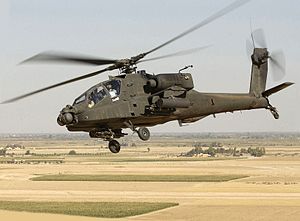





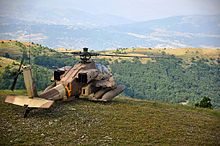
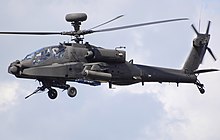

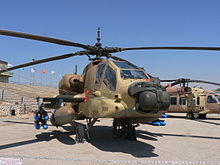
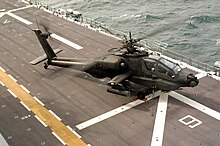



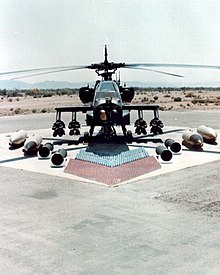










0 Comment:
Posting Komentar